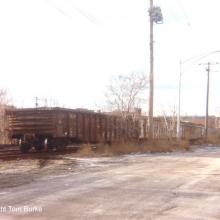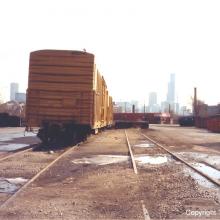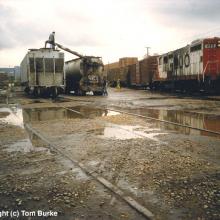
tb_flatcarsgooseisland_01
We're looking at the bankrupt Milwaukee Road's Division St. yard on Goose Island in 1985. In another year the Milwaukee Road itself will be history and Canadian Pacific subsidiary Soo Line will take over operations of most of the former Milwaukee Road lines, including on Goose Island. In its heydey, there were dozens of parallel tracks in this yard with a dedicated locomotive and freight station to keep up with the demands of the Goose Island industries. By 1985 it was a weedy shadow of its former self with many redundant tracks already pulled up.A line of gondolas in apparent scrap steel service are in the foreground, with a boxcar and bulkhead flatcar in the background. Today there are no traces of the yard, which outlived its usefulness when most of the rail-served industries left Goose Island. Instead the City of Chicago and CP Rail built a new line that runs down the middle of the reconstructed Cherry St. to reach Naz-Dar [edit: 10 Jan 2005. Naz-Dar does not receive rail shipments.] and Big Bay Lumber, the last two Goose Island rail customers. Concrete streets, neat curbs, and sidewalks replace the dirt surface of the Cherry St./Division St. area in this view. The yard area now houses various warehouses and commercial buildings.
An excellent view of the Goose Island Divison St. yard from April of 1970 with a transfer run with two GP9s can be found on page 22 of the book "The Milwaukee Road in Color: Volume 1, The East End." It's depressing to compare the two views.
tb_flatcarsgooseisland_01
A line of gondolas in apparent scrap steel service are in the foreground, with a boxcar and bulkhead flatcar in the background. Today there are no traces of the yard, which outlived its usefulness when most of the rail-served industries left Goose Island. Instead the City of Chicago and CP Rail built a new line that runs down the middle of the reconstructed Cherry St. to reach Naz-Dar [edit: 10 Jan 2005. Naz-Dar does not receive rail shipments.] and Big Bay Lumber, the last two Goose Island rail customers. Concrete streets, neat curbs, and sidewalks replace the dirt surface of the Cherry St./Division St. area in this view. The yard area now houses various warehouses and commercial buildings.
An excellent view of the Goose Island Divison St. yard from April of 1970 with a transfer run with two GP9s can be found on page 22 of the book "The Milwaukee Road in Color: Volume 1, The East End." It's depressing to compare the two views.

tb_gooseislandteamtrack_01
A pair of boxcars are spotted at the team tracks on Goose Island at Division and Hickory Streets. Off-line customers use team tracks to send or receive shipments via rail. Note the loading ramp which allows access to the side of a rail car or for loading truck trailers onto a flatcar from the front. Behind the camera and out of view is Waste Management's facility which was capable of receiving freight cars. This photo dates from the early 1990s.tb_gooseislandteamtrack_01

tb_gooseislandteamtrack_02
On a rainy summer day in 1996, a Soo Line patrol is working the team tracks at Division and Hickory Streets. Lots of activity today, with a pair of covered hoppers receiving a load from a truck with a worker on top of one of them directing the flow. A train led by a Soo Line GP-9 appears to be dropping off another hopper and a boxcar on the track to the right, or west, in this view. A pet food company supposedly was one of the shippers using these team tracks.GP9s were used when train lengths were especially long, as well as cabooses. Even in the mid-1990s trains would stretch some 20 cars or more, traveling down city streets on Kingsbury or Cherry. When AKZO/International Salt, a major rail customer for inbound loads of salt, shut down their North Branch facility on the southern end of Goose Island, there were no more long trains.
Prior to the time of this photo the westernmost track crossed Division St. to the south and traveled to almost Halsted St. Even at this late date, you could still see the abandoned section of track re-emerge south of Division St. and travel south along Hooker St. though it was paved over where it crossed Division. As of 2004, nothing remains of this scene as Goose Island converted from heavy manufacturing to commercial and light industry. There was talk about building a new team track but the plans never came about.
tb_gooseislandteamtrack_02
GP9s were used when train lengths were especially long, as well as cabooses. Even in the mid-1990s trains would stretch some 20 cars or more, traveling down city streets on Kingsbury or Cherry. When AKZO/International Salt, a major rail customer for inbound loads of salt, shut down their North Branch facility on the southern end of Goose Island, there were no more long trains.
Prior to the time of this photo the westernmost track crossed Division St. to the south and traveled to almost Halsted St. Even at this late date, you could still see the abandoned section of track re-emerge south of Division St. and travel south along Hooker St. though it was paved over where it crossed Division. As of 2004, nothing remains of this scene as Goose Island converted from heavy manufacturing to commercial and light industry. There was talk about building a new team track but the plans never came about.